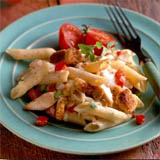
The daily issue of rations was based on standard caloric intake deemed appropriate for troops, and officers’ rations differed in both content and amounts issued from those of the enlisted men. In garrison, this would amount to the standard military fare of meals heavy in carbohydrates and fat, light on meats, and geared toward the activity expected of the soldier.
Given Italian cuisine, one can easily imagine the menu being offered. Pasta or potato dishes, soups, regional stews, some side of tomatoes, fresh vegetables, olive oil, white bread, coffee (or tea, when available) and various sweet breads or cakes, along with standard breakfast items, which included wheat cereals with milk and honey or sugar as condiments, oat meal, sandwich meats, cheeses and white breads/rolls, accompanied spreads such as margarine or butter.
Field Ration:
In the field, rolling kitchens tried to duplicate this ration to a degree, but with more of an eye toward portability and speed of consumption. Many multi-component meals (such as pasta dishes or soups) were issued from a single kettle, with cheese and vegetables added in, along with a side of bread and spot of olive oil as a “dip” for the bread.
As a beverage of convenience, some watered wine was issued, along with the ever-present coffee. In North Africa, field kitchens often substituted tea for coffee, as it could be re-heated more easily, and would also work better for beating thirst. Where available, tinned olives, dried figs and dates, and other fresh fruit, such as the ever-present melons, would be made available to troops.
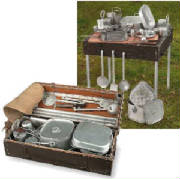
In units equipped with vehicles, such as armored or mechanized components, specific field kitchen sets for food preparation for the officers were part of the basic load, and troops would be detailed, based on skill to prepare meals for officers.
|
 |
| Italian Group Feeding Rations-Razione Giornaliera |
 |
|
 |
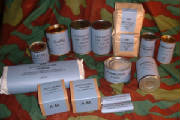
Who Can Cook?
When field kitchens were not available, troops were issued with the so-called RAZIONE GIORNALIERA (RG, “Daily Ration”). This ration, similar in design to British ‘Compo’ rations, was a group feeding rations, portions of which were meant to be cooked in squad-sized elements as a camp food. These items were large tins of fruit, coffee (both soluble and ground varieties in 100 gram tins), boxed sugar, uncooked pasta etc.
Other components were designed as a take-along ration, such as hard bread packages, sweets, fish tins, meat tins and small 1 and 2 portion-sized tins of prepared meal items or condensed soups.
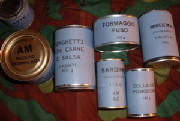
This ration was issued in boxes containing sufficient food for 10 meals. Even though not specifically broken down for specific meals, these 10-man boxes could include breakfast, lunch and dinner items as appropriate. This ration was the second most prevalent ration right behind actual mess hall food. In some units, cooks were “courted” with offers of additional tobacco rations or less soldiering duties, as the components of the RG could be turned into quite passable fare in the hands of a skilled chef!
Personal Ration-Or Personal Insult?
The third type of ration was the RAZIONE PERSONALE (RP, “Personal Ration”), which was issued to troops immediately before action, and which was designed to supply basic food items when group cooking was impossible, on the move, or in breaks during combat. A standard personal ration would include:
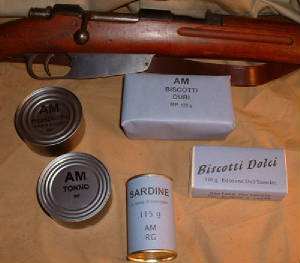
1 can of Tonno (Tuna)
1 can of Prosciutto (Ham)
1 pack of Brodo (Broth Base-2 tablets in a common wrapper)
2 packs Panne Duri (Flatbread)
1 Biscotti Dolci (Sweet Biscuits)
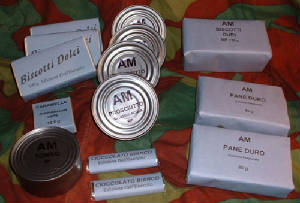
This uninspired ration was not much liked by troops, especially in light of the fact that even the sparse components designed to be included were often not available, and often substituted. In three days of action, a soldier may very well receive 6 cans of tuna fish—and little else.
On the march, when other rations were not available, most soldiers would spend as much time as possible trading with or buying from the local population, in order to provide some variety.
Many soldiers insured to get their fair share and then some of the coffee powder or grounds, as the RP did not come with a beverage pack.
Specialist Rations:
The Italian armed forces had a staggering array of specialist and special circumstance rations and/or ration supplements. One of the more common specialty ration was the Riserva (Reserve) ration, which was carried by most all soldiers as an emergency ration that was not to be used until authorized. It consisted of a “Brick” of hard biscuits or a pack of Panne Duri, a pack of Coffee, Milk and Sugar (soluble and frequently “lost”), and a box of sweets.
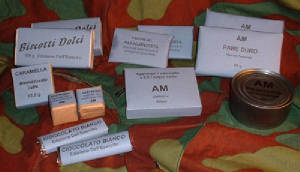
Another frequently seen specialist ration was the Razione del Paracadutista (Parachutists’ Ration). It was issued in a variety of ways, at times supplemented with other ration components or fresh foods suitable for travel, such as hard sausages, dark bread etc. Generally, the Para ration consisted of:
2 Bricks of Razione Emergencia Quotidiana (Daily Ration of Emergency Food). These two bars were sufficient food for 24 hours and only to be eaten under “combat” conditions.
1 Pack of Destrosio (Dextrose tablets or pellets)
1 Pack of Caffé Solubile (Sweetened White Instant Coffee)
1 Pack of Caramella (Hard Candy, Generally Coffee Based)
2 Bars of Cioccolato Bianco (White “tropical” chocolate in ¾ ounce/20 gram bars)
|
|
 |
|
 |
|
|
|
|

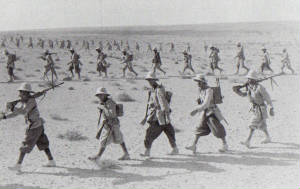




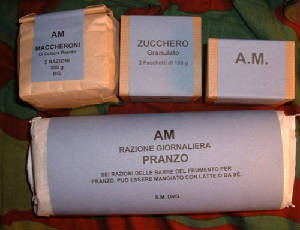



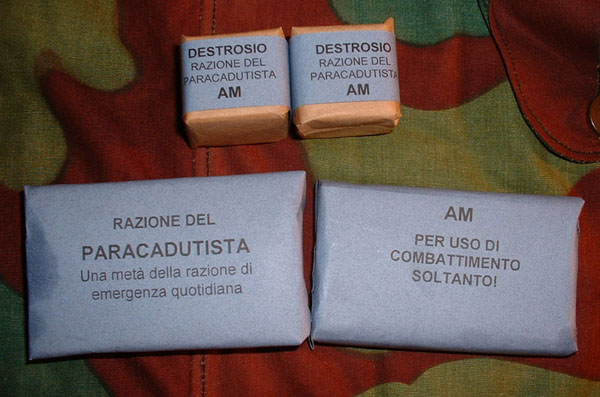
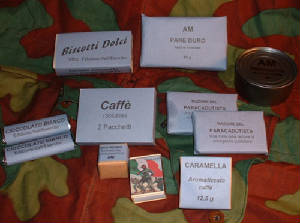
Nenhum comentário:
Postar um comentário